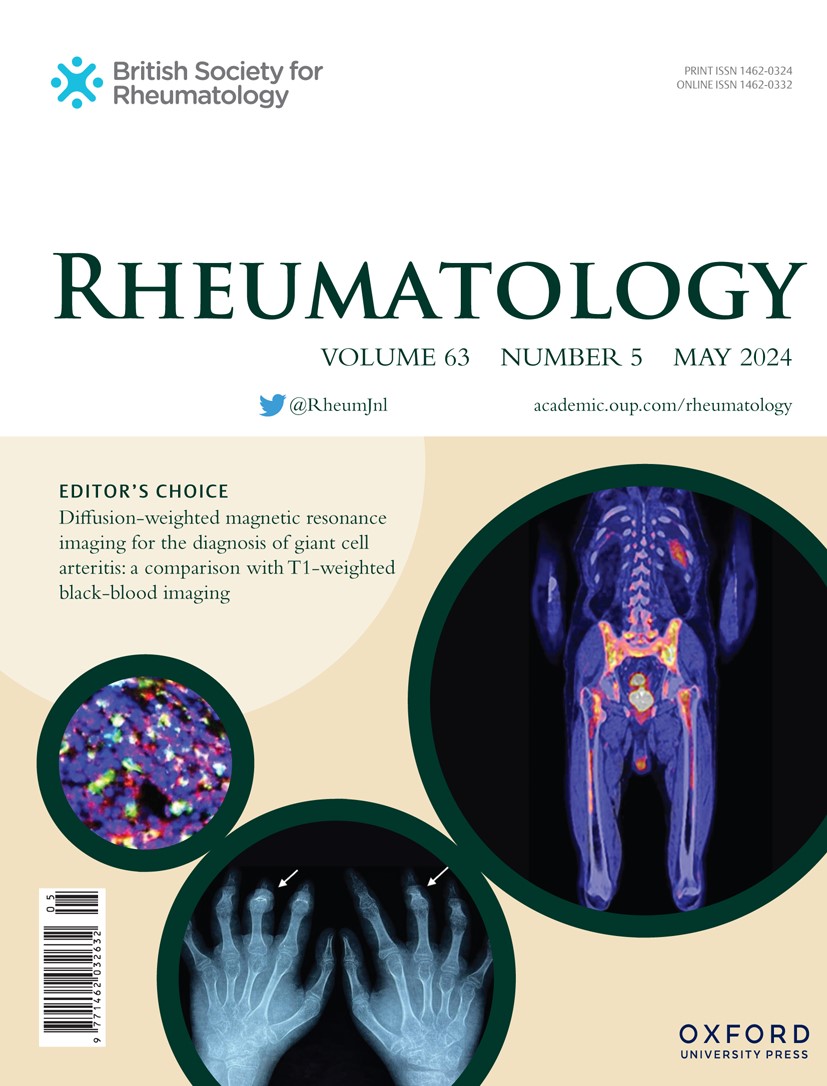P078 A randomised, controlled, double-blind study to evaluate the bioequivalence of FKS518 proposed biosimilar to denosumab with the originator in postmenopausal women with osteoporosis (LUMIADE-3 Study)
IF 4.7
2区 医学
Q1 RHEUMATOLOGY
引用次数: 0
Abstract
Background/Aims Denosumab treatment is growing with the ageing of rheumatic patients, and biosimilars can increase patients’ access to treatment. FKS518 is a candidate biosimilar to denosumab, a RANKL inhibitor used in patients with osteoporosis. To establish biosimilarity with the original biologic, the LUMIADE-3 study (NCT04934072) was designed to assess the safety and efficacy of FKS518 compared to the originator. Methods A randomised controlled, double-blind, multi-centre study on postmenopausal females aged 55-85 years with lumbar spine bone mineral density (LS-BMD) T-score between -2.5 and -4.0 measured by DXA scan. Patients were randomised at a 1:1 ratio for three 60 mg administrations. At week 52, patients receiving denosumab originator product were re-randomised to continue their treatment or switch to FKS518 for the third dose. Those receiving FKS518 continued receiving FKS518. The primary endpoints included the percent change from baseline in LS-BMD DXA at week 52 and the area under the effect curve (AUEC) of serum C-terminal cross-linking telopeptide of type 1 collagen (CTX) up to Week 26. Secondary efficacy endpoints included the percent change from baseline in BMD at femoral neck and total hip. An analysis of the covariance model was used to compare the two treatments. The difference in mean percent change from baseline to Week 52 in LS-BMD and the ratio of means of AUEC (0-W26) CTX along with corresponding 95% Confidence Intervals (CI) were calculated to assess equivalence. FKS518 was considered equivalent to the originator if the 95% CI for LS-BMD lay entirely within the equivalence interval of [-1.45%, 1.45%], and the 95% CI for AUEC (0-W26) lay within the equivalence interval of (0.89, 1.12) ng*h/L. Results 553 patients were randomised to FKS518 (n = 276) or the originator (n = 277). Clinically relevant increases in LS-BMD were evident at week 52 in both the FKS518 and originator product group; least square mean and standard error percent LS-BMD change from baseline were 5.74 (0.315) and 5.07 (0.321) for FKS518 and originator respectively. The 95% CI difference in mean percent change at Week 52 in LS-BMD was equal to [0.04%, 1.29%]. The 95% CI for the ratio of geometric least squares means for AUEC (0-W26) CTX was (0.99,1.04) ng*h/L. Therapeutic equivalence was demonstrated based on both efficacy and pharmacodynamics. All secondary study objectives were met. The safety evaluation did not indicate notable differences between the two treatments; 374 (67.6%) patients experienced treatment emergent adverse events during the 52-week core period: 185 (66.8%) in the FKS518 group and 189 (68.5%) in the originator product group. Conclusion The study demonstrated therapeutic equivalence of FKS518 with the originator and showed similar safety profiles. This study results followed positive preclinical and pharmacokinetic results corroborating the similarity of FKS518 as a proposed biosimilar to denosumab originator product, a RANKL inhibitor. Disclosure I. Valter: None. P. Szeles: Other; Employee of Fresenius Kabi SwissBioSim - Sponsor of the study. A. De Souza: Other; Employee of Fresenius Kabi SwissBioSim - Sponsor of the study. J. Sadek: Other; Employee of Fresenius Kabi US - Sponsor of the study. J. Sykes: Other; Employee of Fresenius Kabi UK - Sponsor of the study. J. Morais: Other; Employee of Fresenius Kabi UK - Sponsor of the study. J. Monnet: Other; Employee of Fresenius Kabi SwissBioSim - Sponsor of the study.一项随机、对照、双盲研究,评估FKS518与地诺单抗的生物类似药在绝经后骨质疏松症妇女中的生物等效性(lumide -3研究)
背景/目的随着风湿病患者的老龄化,Denosumab治疗正在增长,生物仿制药可以增加患者获得治疗的机会。FKS518是denosumab的候选生物类似药,denosumab是一种用于骨质疏松症患者的RANKL抑制剂。为了与原生物制剂建立生物相似性,lumide -3研究(NCT04934072)旨在评估FKS518与原生物制剂相比的安全性和有效性。方法采用随机对照、双盲、多中心研究方法,对55 ~ 85岁绝经后女性腰椎骨密度(LS-BMD) t -评分在-2.5 ~ -4.0之间的DXA扫描进行研究。患者按1:1的比例随机分配三次60mg给药。在第52周,接受denosumab原研产品的患者被重新随机分组,继续他们的治疗或在第三剂量时切换到FKS518。接受FKS518的患者继续接受FKS518。主要终点包括52周时LS-BMD DXA较基线变化的百分比,以及到26周时血清c端交联末端1型胶原(CTX)的效应曲线下面积(AUEC)。次要疗效终点包括股骨颈和全髋关节骨密度较基线变化的百分比。采用协方差模型分析比较两种处理。计算LS-BMD从基线到第52周的平均百分比变化差值和AUEC (0-W26) CTX的平均值之比以及相应的95%置信区间(CI)以评估等效性。如果LS-BMD的95% CI完全在[-1.45%,1.45%]的等效区间内,认为FKS518与始发源等效,AUEC (0-W26)的95% CI完全在(0.89,1.12)ng*h/L的等效区间内。结果553例患者被随机分配到FKS518组(276例)或原药组(277例)。FKS518组和原药组临床相关的LS-BMD在第52周明显升高;与基线相比,FKS518的最小二乘平均值和标准误差百分比分别为5.74(0.315)和5.07(0.321)。第52周时LS-BMD平均百分比变化的95% CI差等于[0.04%,1.29%]。AUEC (0-W26) CTX的几何最小二乘均值比值的95% CI为(0.99,1.04)ng*h/L。根据疗效和药效学证明了治疗等效性。所有次要研究目标均已达到。安全性评价显示两种治疗间无显著差异;374例(67.6%)患者在52周的核心期内出现治疗紧急不良事件:FKS518组185例(66.8%),原药组189例(68.5%)。结论FKS518与原药具有相同的疗效,且具有相似的安全性。该研究结果是在阳性的临床前和药代动力学结果证实FKS518作为拟议的生物类似药与denosumab原药产品(RANKL抑制剂)的相似性之后得出的。1 .瓦尔特:没有。P. Szeles:其他;Fresenius Kabi SwissBioSim的员工-该研究的赞助商。A. De Souza:其他;Fresenius Kabi SwissBioSim的员工-该研究的赞助商。J. Sadek:其他;费森尤斯卡比美国公司雇员-本研究的赞助商。J.赛克斯:其他;费森尤斯卡比英国公司员工-本研究的赞助商。莫莱斯:其他;费森尤斯卡比英国公司员工-本研究的赞助商。莫内:其他的;Fresenius Kabi SwissBioSim的员工-该研究的赞助商。
本文章由计算机程序翻译,如有差异,请以英文原文为准。
求助全文
约1分钟内获得全文
求助全文
来源期刊

Rheumatology
医学-风湿病学
CiteScore
9.40
自引率
7.30%
发文量
1091
审稿时长
2 months
期刊介绍:
Rheumatology strives to support research and discovery by publishing the highest quality original scientific papers with a focus on basic, clinical and translational research. The journal’s subject areas cover a wide range of paediatric and adult rheumatological conditions from an international perspective. It is an official journal of the British Society for Rheumatology, published by Oxford University Press.
Rheumatology publishes original articles, reviews, editorials, guidelines, concise reports, meta-analyses, original case reports, clinical vignettes, letters and matters arising from published material. The journal takes pride in serving the global rheumatology community, with a focus on high societal impact in the form of podcasts, videos and extended social media presence, and utilizing metrics such as Altmetric. Keep up to date by following the journal on Twitter @RheumJnl.
 求助内容:
求助内容: 应助结果提醒方式:
应助结果提醒方式:


